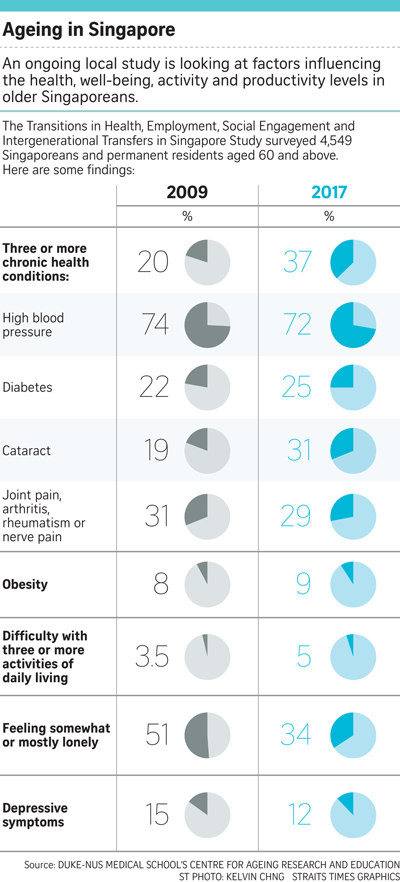Survey finds more of them are also having difficulty carrying out daily living activities
The proportion of older adults with three or more chronic diseases nearly doubled from 2009 to 2017, a local study has found.
More Singaporeans aged 60 and above are also having difficulty carrying out daily living activities, based on an ongoing survey of more than 4,500 Singaporeans and permanent residents, details of which were revealed yesterday.
The Transitions in Health, Employment, Social Engagement and Intergenerational Transfers in Singapore Study is being carried out by the Duke-NUS Medical School's Centre for Ageing Research and Education, together with the Ministry of Health.
The study focuses on physical health and healthcare utilisation, psychological well-being, social networks, social participation, inter-generational transfers within the family, volunteerism, life-long learning, work and retirement.
It is estimated that by 2030, a quarter of Singapore's population will be above the age of 65.
Some 37 per cent of respondents reported three or more chronic health conditions in 2017, up from 19.8 per cent in a 2009 study.
The top five chronic health conditions were high blood pressure; high blood cholesterol; cataract; joint pain, arthritis, rheumatism or nerve pain; and diabetes.
"The fact that nearly a third of the respondents have three or more chronic health conditions is worrying," said Dr Rahul Malhotra, the centre's head of research.
"There could be two possibilities: The 2016/2017 cohort is more educated and has greater access to health facilities, and the Government has launched a lot of screening programmes, so a lot of them have benefited from that.
"The other possibility is that it reflects a worsening health situation."

"It is estimated that by 2030, a quarter of Singapore's population will be above the age of 65. Some 37 per cent of survey respondents reported three or more chronic health conditions in 2017, up from 19.8 per cent in a 2009 study."
A greater number of older adults also struggled with basic activities like eating and showering. In 2017, about 4 per cent reported difficulty with one or two daily activities, up from 2.8 per cent in 2009.
Five per cent reported difficulty with three or more such activities, up from 3.5 per cent in 2009.
More women than men reported these difficulties, with 13 per cent and 5 per cent respectively.
"Having difficulty with an ADL (activity of daily living) is more reflective of the severity of the health condition, rather than the presence of the health condition, so it could be that more older Singaporeans today have more advanced stages of the disease," said Dr Malhotra.
He added that problems with daily activities increase much more after the age of 75.
Dr Alvina Nam, a family physician at Clinic@Costa, agreed that the rise in the proportion of people with these problems could be a reflection of greater health awareness, leading to better diagnoses and a rise in people willing to be tested, diagnosed and treated.
"Other reasons are likely due to an increasing sedentary lifestyle, and with a better income, many are also willing to spend more on food, which makes dieting difficult," she said.
"A continuous campaign to instil the importance of a balanced diet and regular exercise is important, with an emphasis on getting families involved in eating and exercising right together."
The Centre for Ageing Research and Education is conducting the second wave of the study, which is due to be completed this year.
OLDER GENERATION DEVELOPING BRIGHTER OUTLOOK, RESEARCH SUGGESTSWhile the physical health of older people here has taken a hit, their mental health has improved. The prevalence of clinically depressive symptoms among older Singaporeans fell from 15 per cent in 2009 to 12 per cent in 2017. This was accompanied by a decrease in the proportion of respondents who felt somewhat or mostly lonely - from 51 per cent in 2009 to 34 per cent in 2017. "A potential reason is the befriending programmes are working - the Silver Generation Office has about 4,000 volunteers knocking on the doors of disadvantaged elderly who tend to live alone," said Dr Angelique Chan, executive director of Duke-NUS Medical School's Centre for Ageing Research and Education. While more older Singaporeans are living alone - 7.3 per cent in 2017, up from 6.2 per cent in 2009 - it is not necessarily a yardstick for measuring loneliness. Of those who live alone, 40 per cent reported feelings of loneliness, compared with 33 per cent of those who live with somebody, said Dr Rahul Malhotra, the centre's head of research. "If you're living with somebody, you have more chances of being left out in daily things," he added. "If you're living alone, maybe you are used to it and have found your own mechanisms to deal with it... it's a misnomer that living alone equates to loneliness." However, researchers also found that being lonely was linked to lower levels of healthcare use, such as visiting doctors and hospitals. It could be due to such people being more socially withdrawn, not wanting to be a burden on others, and language difficulties. The slight dip in the proportion of the elderly with depressive symptoms could also be due to the fact that the 2017 cohort is more educated than the 2009 one. "They're more likely to be working and interacting with people," said Dr Chan. Stronger social networks were linked to a lower likelihood of depression and loneliness, the study noted. |
